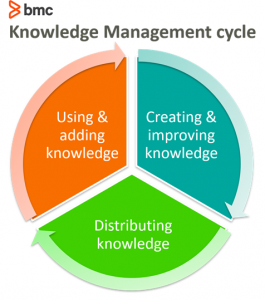Knowledge Management is the process of generating, storing, sharing, and managing information. In the age of big data, we know that information can be overwhelming—yet it promises unprecedented business opportunities for those who practice Knowledge Management to perfection.
In this article, we will discuss the industry-proven ITIL® Knowledge Management guidelines and best-practices that will help maximize the value potential of your Knowledge Management strategy. Whether you fully adopt the ITIL framework or not, these guidelines can help any organization with their knowledge management efforts.
What is knowledge? Why manage it?
Knowledge is increasingly being viewed as a commodity or an intellectual asset—that knowing something offers its own benefits, beyond merely doing or producing something. Knowledge is generally divided into three types:
- Explicit: Information from tangible sources, such as books, newspapers, or articles.
- Implicit: Information that does not originate in a tangible form, but can be transferred into tangible form, such as a dictation of a speech or an experience.
- Tacit: Information that’s difficult to capture tangibly, such as your perception of an experience or a feeling after a big event.
No matter which type, this information can exist in a few categories:
- Data: a collection of facts
- Information: raw data enhanced with context
- Knowledge: the high-level insight extracted from analyzing data and information
- Wisdom: the knowledge applicable to decision-making
Companies, then, want to manage this knowledge, primarily explicit knowledge about their market, their industry, and their products. Over time, your knowledge can even grow into wisdom. Knowledge Management helps improve innovation and time-to-market, makes work clearer and more achievable for employees, and underpins your competitive edge.
The Knowledge Management process is broken into a continuous cycle of three phases:

Knowledge Management best practices
Of course, within these three Knowledge Management phases, there are plenty of best practices that can take you from beginner to expert execution of your organizational knowledge. These best practices are focuses specifically on IT service delivery, but can be incorporated into any type of knowledge management.
1. Know your problems
Before initiating a Knowledge Management program, understand the underlying challenges you face. Knowledge Management goes beyond investments in technology and requires organizations to facilitate the culture and process that enable effective Knowledge Management.
Instigate change in your people and culture that makes it easier to create, find, and share useful knowledge. The first step is to define what Knowledge Management means at the individual level:
- Is your knowledge management simply a set of tasks for a specific number of the IT department?
- Or, is it a platform for the entire organization to contribute and assist?
Some key challenges result due to common mistakes, such as an inadequate understanding of the ITIL framework or the focus on capturing knowledge. Instead of treating knowledge management as a separate activity with isolated tasks, you should integrate Knowledge Management practices within existing processes and business activities. Integrating your knowledge management ensures that the knowledge associated with all critical business operations is generated and captured at scale, without unnecessary delays or complexity of managing knowledge as a separate process.
2. Measure the metrics
As the popular business maxim goes, you can’t manage what you don’t measure and if you can’t measure it, you can’t improve it. Measuring the performance of Knowledge Management initiatives can be difficult considering that the underlying operational processes are designed, conducted, and then evaluated based on references that the organization creates internally. These references may not always present a true performance evaluation, but several alternative KPIs and references can be used instead.
For example, evaluate the KPIs for Incident Management functions related to the service knowledge management system (SKMS). Measure the activity within the SKMS—Are users able to find useful information efficiently? Does the provided knowledge solve a user request or ticket?
3. Don’t just manage knowledge—exploit It
Knowledge Management encompasses your capacity as well as the actual tasks to collect, store, and manage knowledge. However, the goal of Knowledge Management initiatives may be lost when most resources and frameworks are designed merely to manage the knowledge instead of exploiting it.
Your company should design a Knowledge Management program that brings about the changes necessary to utilize the available knowledge effectively:
- Measure the growth and improvement in Knowledge Management programs in terms of scalability across the technology and people.
- Conduct surveys and gauge metrics that provide detailed description of end-user experience in creating, sharing and consuming knowledge.
4. Make knowledge consumable and diverse
Knowledge Management can be a complex and resource-consuming job function. Especially in large enterprises that must create and manage vast knowledge resources, employees tend to struggle in identifying appropriate problem-solutions from the available pool of knowledge items.
Instead of dumping knowledge across long articles (a time-consuming process for the writer and the reader alike), present your knowledge in a more user-friendly manner. Replace long articles and explanations with short, actionable guidelines. Adopt a consistent, standardized format for all documentation to make it easier for employees to spot the answers they need urgently.
Don’t limit your knowledge documentation to text only. Diversify and complement your knowledge management platform with collaboration tools, live chat, and service desk and chatbot support. Accessing the knowledge should not require a focused effort to manually go through large repositories of long articles. Follow a consumer-centric instead of a supplier-based approach. The goal of Knowledge Management is not just to supply the data and information, but also for end-users to easily consume and apply the underlying knowledge.
Often, the purpose of accessing knowledge for an individual can be fulfilled far more efficiently by communicating and collaborating with others. In fact, this is a primary reason for the industry-wide adoption of DevOps SDLC practices that encourage shared responsibility and knowledge sharing between individuals from otherwise separate job functions working collectively on the same SDLC project pipeline.
Consider how some people learn in different ways—can you create quick videos to show an answer or process? What about a living wiki document that users can update as they find or improve knowledge and solutions?
5. Scale your knowledge sharing
Develop the necessary processes that conveniently allow users not only to create and access knowledge, but to adopt it in their routine tasks. Traditional Knowledge Management follows a one-way approach where only the IT department is responsible for producing knowledge. Employees who require a solution that’s not already documented by IT must go on a journey: finding employees who experienced the same issue, resolving the issue, and, now, holding knowledge of the appropriate solutions.
Knowledge sharing should be made convenient for employees and non-IT folks, just as they would share information using social-media channels, wikis, and mobile apps. Incentivize knowledge sharing activities as it improves the overall capacity of the organization to learn and improve by solving problems for each other efficiently instead of overwhelming the Service Desk.
An additional layer of automation and intelligence can further augment the management aspect of the knowledge created by employees. ITSM technologies offering AI capabilities can work through the information and bring the most useful knowledge to appropriate users when needed, in a standardized and convenient format.
Knowledge Management is essential to successful ITSM
Finally, it is important to adopt Knowledge Management as a key function in ITSM that will help individual employees solve problems collectively at scale. Although the Knowledge Management process itself will be followed by appropriate employees in the IT department and advanced technology solutions, the success of Knowledge Management initiatives will largely depend on how the wider organization contributes and consumes the knowledge.







